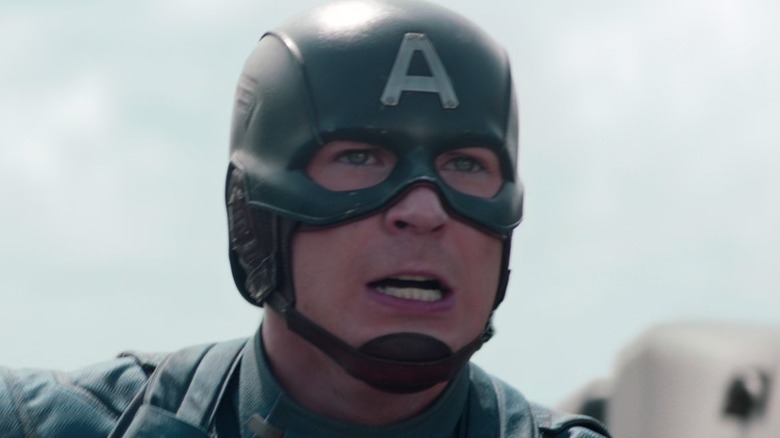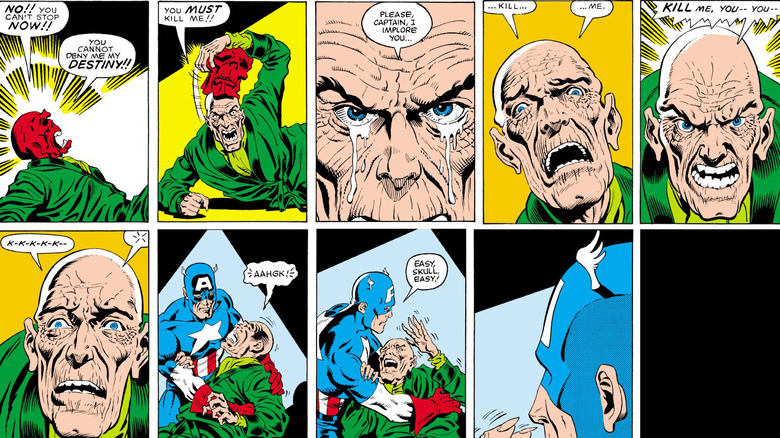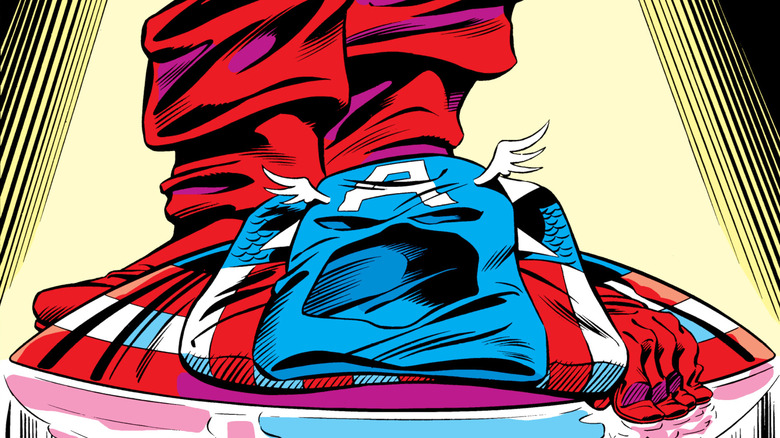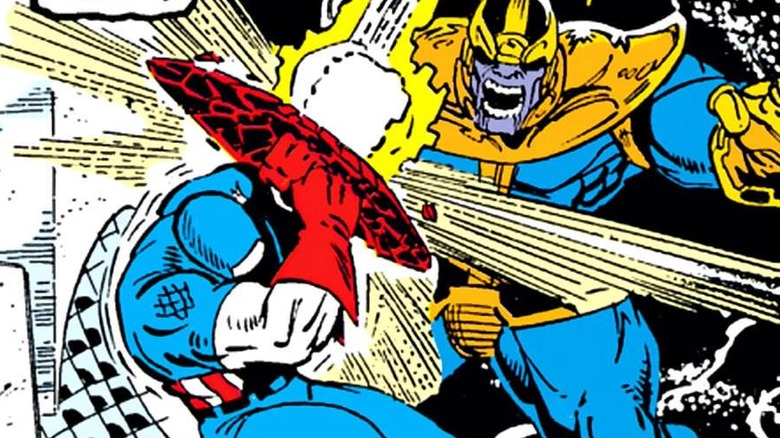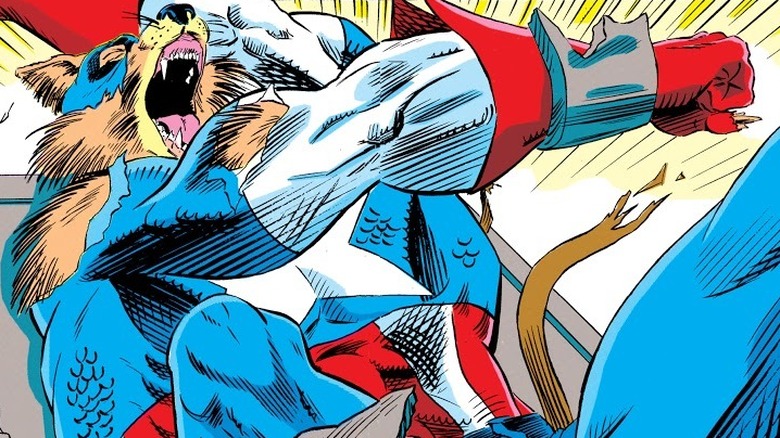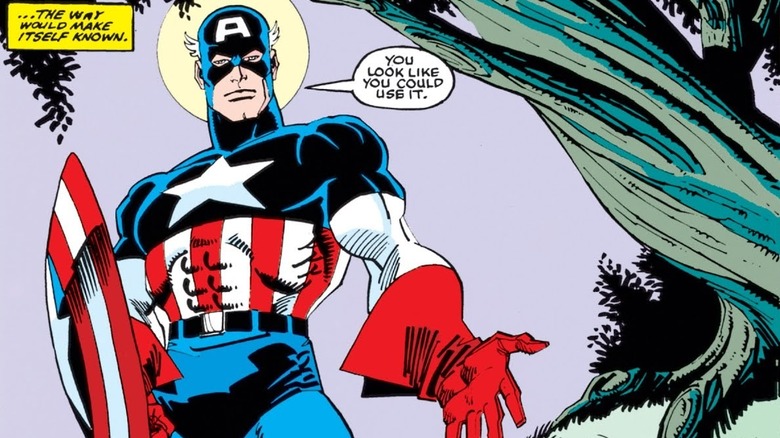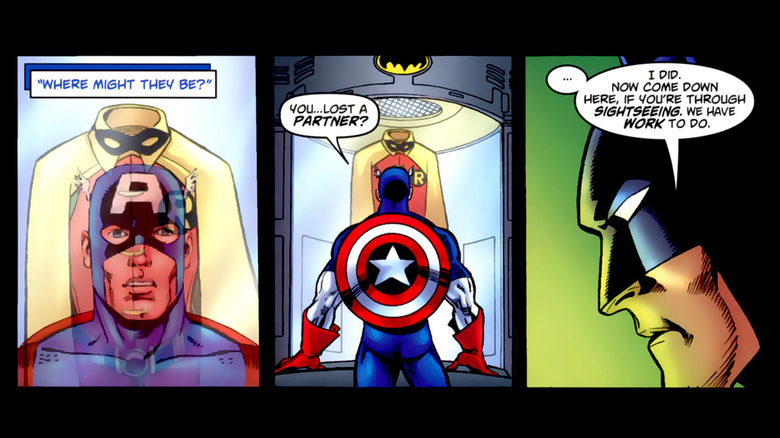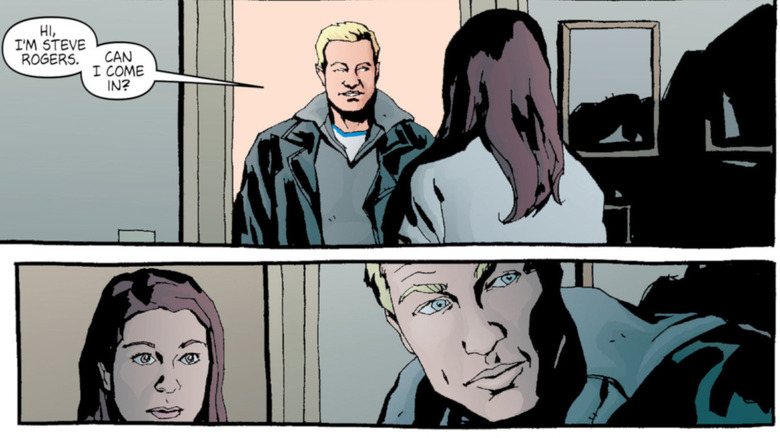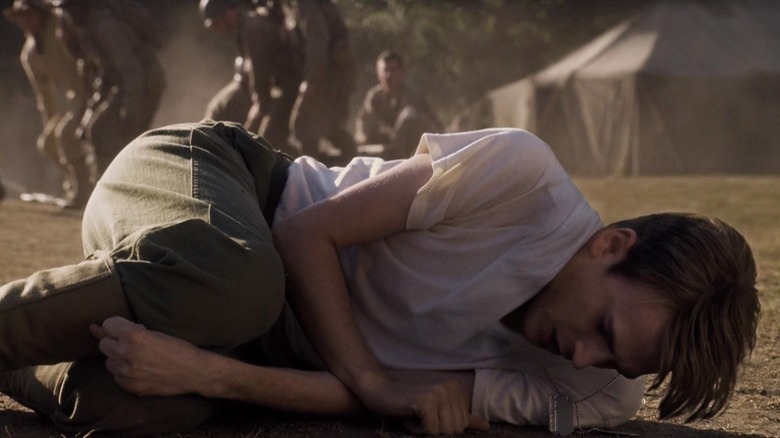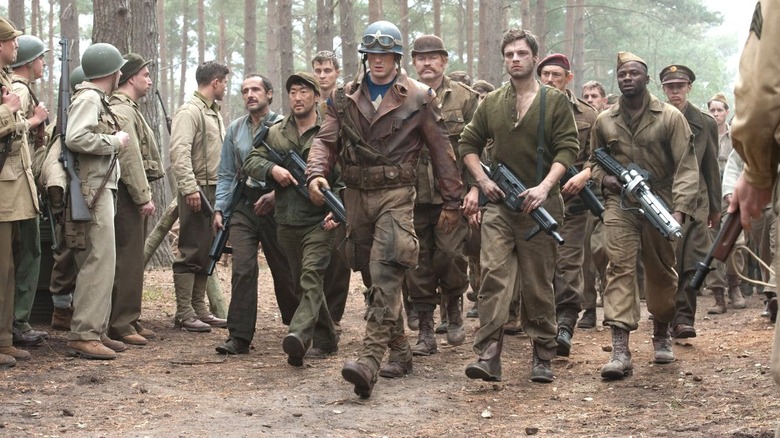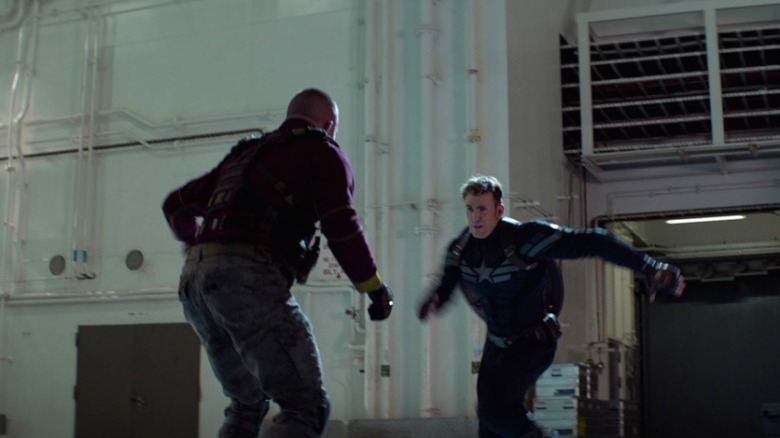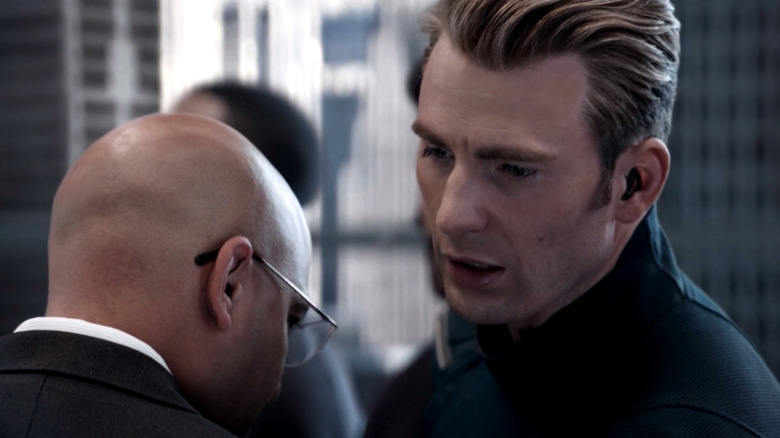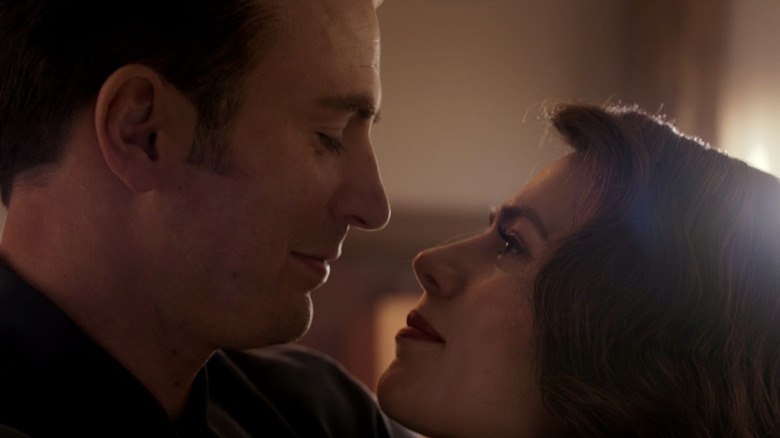Captain America's Most Underrated Moments
Captain America, specifically in the form of Steve Rogers, is one of the greatest Marvel heroes of all time. His time in the MCU may be over, but he's still going strong in comics and other media, and he pretty much has been around (with a little gap here and there) since Joe Simon and Jack Kirby created him in 1941.
There are a lot of great Captain America moments, both in the comics and the movies. Highlights include him punching Hitler on the cover of "Captain America Comics" #1 (a moment recreated as part of a stage show in "Captain America: The First Avenger), and when he is unfrozen by the Avengers in "Avengers" #4. Also iconic are the elevator fight in "Captain America: The Winter Soldier" and his confrontation with Iron Man in "Captain America: Civil War." Equally unforgettable is when he wields Thor's hammer against Thanos in "Avengers: Endgame."
Let's look beyond those obvious top 10 memories and consider the Captain America heroics that get a little less attention. In both Marvel Comics and the MCU, these are Captain America's most underrated moments.
He watched the Red Skull die in his arms
The Red Skull has always been Captain America's greatest nemesis. Originally empowered by Adolf Hitler, Johann Schmidt becomes the embodiment of fascism, oppression, and rule through fear, just as Steve Rogers embodies freedom, hope, and democracy. When Cap is frozen in the arctic ice, Red Skull is also in suspended animation for decades, trapped in a collapsed bunker where he is exposed to an experimental gas that halts his aging process. He is revived soon after Steve Rogers' return, enabling him to continue bedeviling his greatest enemy through the years.
However, in a 1984 story by J.M. DeMatteis, Michael Ellis, and Paul Neary, the Red Skull finds the effects of the gas wearing off, causing him to age into a frail man in his 80s. Determined to die in battle with Captain America, Red Skull captures and artificially ages Cap as well, in "Captain America" Vol. 1 #300. The two old men fight briefly, but Red Skull is too weak to carry on for long. With tears in his eyes, the Red Skull tears off his mask and begs Captain America to kill him. Cap refuses, however, and holds the pathetic, hateful old man in his arms and watches him die.
This being comic books, the Red Skull would return by the beginning of the '90s, but the story of his original death is still a powerful one.
Captain America quit over his principles
Steve Rogers is known for his speeches as much as for his ability to throw a shield. One of his best speeches, ironically, is given when he quits being Captain America. In 1987, a government commission attempts to put tighter reins on Cap's actions. However, Captain America's autonomy is always what made him a true hero instead of a government stooge. Ever since he is unfrozen and joins the Avengers, the government never gives him direct orders, until this story.
In "Captain America" Vol. 1 #332 by Mark Gruenwald and Tom Morgan, Steve is told that if he wants to keep being Captain America, he will have to work directly under their supervision. He struggles with the decision but ultimately tells them exactly where he stands, explaining, "Captain America was created to be a mere soldier, But I have made him far more than that. To return to being a mere soldier would be a betrayal of all I've striven for, for the better part of my career. To serve the country your way, I would have to give up my personal freedom ... My commitment to the ideals of this country is greater than my commitment to a 40-year old document. I am sorry, but that's the way it must be. Gentlemen, I believe these are yours."
With that, he places his uniform and shield on the desk and walks out. Steve Rogers would eventually earn back both his gear and his autonomy, of course, but that would take 18 issues and a disastrous showing by his replacement, John Walker.
He stood up to Thanos when the odds were impossible
Marvel Comics' original "Infinity Gauntlet" story, by Jim Starlin, George Pérez, and Ron Lim, is different from the movie version in a number of ways. Perhaps the biggest is that Thanos doesn't destroy the gauntlet and retire to a quiet planet after snuffing out half the life in the universe. The comic book version of Thanos is quite happy to remain a godlike being of infinite power and lord it over the Marvel Universe. That means the surviving heroes have to go up against him at the absolute height of his power, and most of them are quickly dispatched. One of the few remaining heroes is Captain America, who, of course, has no cosmic powers at all. He's just a reasonably strong and nimble guy who never backs down from a worthy fight.
Nevertheless, Steve gets right up in Thanos' face and makes it clear that he has no intention of backing down. He knows he has no chance of stopping Thanos, or indeed of even surviving the encounter, but he stands up to him anyway, because that's what Captain America does. As it turns out, the momentary distraction provided by his last stand leads to a series of events that brings about Thanos' defeat.
Captain America was briefly a werewolf
Most of this list is made up of heartfelt, moving, and inspirational moments, which makes sense because Captain America has always been good at that stuff. Of course, that's not all that superhero stories can be. Some of the best stories in comics are great because they're ridiculous and take you on a fun, twisty ride. Take, for example, "Man and Wolf," a 1992 saga by Mark Gruenwald and Rik Levins in which Captain America gets involved in a plot involving most of the Marvel Universe's prominent werewolves, as well as other semi-feral characters such as Wolverine.
At the story's climax, in "Captain America" Vol. 1 #405, Captain America himself is transformed into a wolfman. Capwolf, as he's usually referred to in this form, teams up with the other wolf folks to take down the evil druid who's responsible for all these lycanthropic shenanigans. He even gives one of his signature inspirational speeches, except it's mostly unintelligible because he's a werewolf. It's a lot of ridiculous fun, and, of course, Cap's wolfism is cured by the end of the story.
He showed up just when Spider-Man needed him
"Maximum Carnage" was one of the biggest Spider-Man stories of the 1990s and certainly the most '90s of Spider-Man stories. The 1993 tale featured Spider-Man teaming up with his old enemy Venom to deal with their common enemy, Carnage. Other heroes, including the mutant Firestar, join in the fight, but Carnage proves to be too much for them all.
Venom, in true '90s anti-hero fashion, encourages Spider-Man to use lethal force against Carnage, but Spider-Man resists that temptation. in "Spectacular Spider-Man" Vol. 1 #202 by J.M. DeMatteis and Sal Buscema, however, the heroes' seeming inability to defeat Carnage gets to be too much for Spider-Man, and he tells Firestar to blast him with a lethal dose of her microwave powers. He quickly realizes what a mistake that would be, however, and tells her to stop before Carnage is killed. Venom turns on them over this, and Carnage recovers and leaves with a captured Venom.
Spider-Man is left sprawled on the ground, thinking about how he can't seem to pause long enough to find a better path from Carnage and Venom's madness. Amid his despair, a voice from off-panel asks, "How 'bout a hand, son?" A full-page splash of Captain America follows, the full moon behind him like a halo, offering Spider-Man a helping hand. It's immediately clear that Captain America's presence means that everything is going to be okay. There's nobody Spider-Man would rather see in his darkest moment, and that's what Captain America is all about.
He visited the Batcave
"JLA/Avengers" by Kurt Busiek and George Pérez is the kind of crossover book it's hard to imagine now. Still, the world was simpler in 2003, and Marvel and DC came together to publish the multiverse-spanning miniseries that fans had long been clamoring for. Manipulated by cosmic beings from both universes, the Justice League and the Avengers soon find themselves in conflict. Batman and Captain America, however, realize pretty quickly that something deeper is going on and remove themselves from the fight to investigate. Batman takes Cap to the Batcave, where he contacts Oracle to help him figure things out.
Meanwhile, Captain America, who hadn't realized how much he has in common with the Dark Knight, stares at the memorial display of Jason Todd's Robin costume. For fans looking at this almost two decades later, it's important to remember that in 2003 Jason Todd was still dead, as was Bucky Barnes. "You ... lost a partner?" asks a visibly moved Cap. Never one for an emotional moment, Batman simply responds, "... I did," and gets back to business. It's a great little human moment in the midst of a huge gonzo crossover.
Steve Rogers shared a private moment with Jessica Jones
Long before Jessica Jones had her own series on Netflix, she was the lead character in the Marvel Max comic "Alias" by Brian Michael Bendis and Michael Gaydos. In that book's first storyline, she is manipulated into recording Steve Rogers becoming Captain America in a video that could reveal his secret identity to the world. She doesn't really know Captain America, but she certainly doesn't want to do him harm, and she knows that a lot of very bad people would probably kill for such a video. In fact, they might kill her for it. Cynical but well-meaning, Jessica does her best to do the right thing, even contacting her ex-boyfriend, a SHIELD agent, to help her navigate the situation.
At the end of the story, after the real bad guys have been dealt with, there's a knock on Jessica's apartment door. "Hi," says the handsome blond man when she answers it, "I'm Steve Rogers. Can I come in?" She says yes, of course, and the two have a brief interaction that demonstrates just what an impressive man Captain America would be to meet, even when he's in street clothes. He's kind, genuine, and doesn't treat anybody like they're beneath him. Steve and Jessica have so much chemistry that a later "What If ..." story envisions an alternate timeline where the two of them eventually get married.
He proved he was a hero before his transformation
Before Steve Rogers is injected with the super-soldier serum and dosed with vita-rays, he is just a scrawny unhealthy kid who is rejected multiple times by the army. His first MCU movie, "Captain America: The First Avenger," does a great job of depicting this, using surprisingly effective CGI to create a much smaller version of Chris Evans as young Steve. It's in this form that Steve Rogers proves his worth to Colonel Phillips (Tommy Lee Jones), the skeptical army officer in charge of the super-soldier project.
Discussing candidates with head scientist Abraham Erskine (Stanley Tucci), Phillips comments that winning wars takes guys. He then pulls the pin on a grenade and tosses it into the midst of the soldiers. While everyone else scatters and takes cover, including Phillips' preferred pick, the physically impressive Hodge (Lex Shrapnel), Steve Rogers jumps on top of the grenade, doing his best to shield everyone else from the explosion with his body. Of course, there is no explosion. The grenade was never really live, but it shows Phillips and everyone else that Steve Rogers isn't just the nicest guy there, he's the one with the most guts. Even before he becomes a perfect physical specimen, he already has the heart of a hero.
Captain America went rogue to save lives
After Erskine is killed and his formula is lost in "Captain America: The First Avenger," it's clear there will be no more super soldiers besides Steve Rogers. Not knowing what else to do with him, the military dresses Steve up in a colorful Captain America costume and sends him on tour to sell war bonds across the country. Steve soon finds himself in Europe, performing for active soldiers who are much less receptive to the schtick than the civilian public. He hears that his oldest friend Bucky Barnes (Sebastian Stan), along with a bunch of other soldiers, has gone missing behind enemy lines not far away. Seeing that nobody else is going to do anything except mark them down as lost, Steve decides to take matters into his own hands.
Recruiting Howard Stark (Dominic Cooper) to drop him behind enemy lines, Steve singlehandedly rescues Bucky and quite a few other soldiers, proudly marching them back to base. In his first real act of heroism in the guise of Captain America, Steve proves that he's much more than a soldier — he's a hero who will do the right thing whether he's authorized to or not. Fortunately, that impresses everyone enough that he's given the freedom to remain active as Captain America in the war, alongside Bucky and the other "Howling Commandos" he rescued.
He gave Batroc the fight he was looking for
If you weren't familiar with the "Captain America" comics, you probably didn't catch the significance of the fight between Steve Rogers and Georges Batroc (Georges St-Pierre), the kickboxing leader of the high-tech pirates in the opening sequence of "Captain America: The Winter Soldier." The physically imposing Batroc seems excited to fight Captain America, and Cap indulges him with some unarmed combat amid a much larger mission. Comics fans, of course, knew exactly who this guy was and why that fight was a nod to Batroc's much great significance in the Marvel Comics universe.
Batroc the Leaper was first introduced by none other than Stan Lee and Jack Kirby in the Captain America story in "Tales of Suspense" #75, way back in 1966. He's remained one of Cap's most persistent villains ever sense, standing apart from fascist monsters like the Red Skull and Arnim Zola by just being a mercenary who's often likable in his flamboyance and audacity, even when he's doing bad things. A master of the French kickboxing form known as savate, Batroc is a guy who really enjoys fighting. Naturally, that means he particularly loves to fight Captain America, one of the best fighters in the world. It's a shame he didn't get more to do in the MCU (although he did make a return appearance in "The Falcon and the Winter Soldier"), but at least fans got one memorable fight between Batroc and his favorite opponent.
He knew just what to say to avoid a fight
One of the most controversial Captain America stories of all time happened in 2016 when cosmic manipulation of the timeline retroactively made Steve Rogers a Hydra sleeper agent, as revealed on the last page of "Steve Rogers: Captain America" #1, when Cap says, "Hail Hydra." Eventually, the timeline shenanigans are revealed, and the true Steve Rogers returns to defeat his fascist doppelgänger, but by then the story, and writer Nick Spencer, had already made fans mad by making the original anti-fascist superhero into a temporary fascist.
"Avengers: Endgame" includes a nod to this, which managed to amuse both those who hated the storyline and those who enjoyed it. When the Avengers travel into the past to recover the Infinity Stones, Captain America is tasked with retrieving Loki's staff, which contains the Mind Stone, in the first "Avengers" film. Unfortunately, that item is already in the hands of a group of SHIELD agents, who Cap joins on an elevator. He recognizes Jasper Sitwell (Maximiliano Hernández) and Brock Rumlow (Frank Grillo), who are revealed as Hydra agents in "Captain America: The Winter Soldier" (which is in their future, so they don't know he knows). When they resist giving him the case containing the staff, it briefly seems like another elevator fight might break out, like the famous one in "Winter Soldier," but instead Cap leans close to Sitwell's ear and whispers, "Hail Hydra." The next shot shows Captain America stepping off the elevator, case in hand.
Steve Rogers finally got to dance with Peggy Carter
When Chris Evans left the MCU, it was on "Avengers: Endgame" to bring Steve Rogers' story to a close, and it was pretty great how it happened. Way back in "First Avenger," Steve promises Peggy Carter (Hayley Atwell) a dance when he gets back from his mission to stop the Red Skull, but he ends up frozen in ice and doesn't come back for seventy years. However, the time travel element introduced in "Endgame" gives their romance a new lease on life. After the Avengers defeat Thanos, Steve uses the time machine to return the Infinity Stones to their proper timelines. He then reappears as an older man who's lived a long, happy life in another timeline, passes on his shield to the Falcon, and disappears in the sunset.
As the movie closes, however, we get a glimpse of that new timeline. Decades in the past, we see an ordinary house on a normal street. As the camera pushes in through a window, a couple dances in the living room. It's young Steve and Peggy, reunited with a new future laid out ahead of them. They finally get their long-promised dance, and enjoy a kiss just as the movie cuts to black.
There will always be a Captain America, and for some fans, that Captain America will always be Steve Rogers. But just this once, in this one timeline of the MCU, Captain America gets to have a happy ending with the woman he loves. And frankly, he deserves it.
